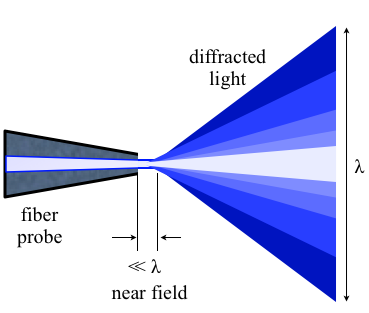Near-Field Optics: Nanoscale Imaging & Analysis Techniques
Definition: Near-field optics is a branch of optics that focuses on the behavior of light in sub-wavelength scales, allowing the study of optical phenomena beyond the diffraction limit of light. This field enables the visualization and manipulation of nanostructures and nanoscale phenomena, offering unprecedented detail and resolution.

Understanding Near-Field Optics
Near-field optics operates on the principle that when light interacts with objects smaller than its wavelength, it can produce an evanescent wave that decays exponentially with distance but provides significant detail at very close ranges. This principle is exploited to overcome the traditional diffraction limit, enabling the observation of features that are much smaller than the wavelength of light used.
Scanning Near-Field Optical Microscopy (SNOM)
A key tool in near-field optics is the Scanning Near-Field Optical Microscope (SNOM), which combines the high-resolution capabilities of near-field techniques with the versatility of scanning probe microscopy. SNOM allows for imaging, spectroscopy, and manipulation of nanostructures with resolution beyond the diffraction limit.
Principles of Operation
SNOM operates by scanning a sharp tip, which is illuminated by light, very close to the sample surface. The tip confines the light into a tiny spot, enabling the study of nanoscale features. The interaction between the tip and the sample modulates the light, which is then collected and analyzed to generate images or spectra.
Key Features and Applications
Near-field optics, particularly through SNOM, offers several benefits:
- High Spatial Resolution: By bypassing the diffraction limit, near-field optics achieves resolutions down to the nanometer scale, essential for nanotechnology, materials science, and biology.
- Material Characterization: It allows detailed analysis of the optical properties of materials at the nanoscale, including semiconductors, metals, and biological specimens.
- Surface Studies: Near-field optics is invaluable for examining surface phenomena, chemical reactions at surfaces, and thin film analysis.
- Photonic Devices: It plays a crucial role in the development and testing of photonic devices like waveguides, photonic crystals, and nanoantennas.
Advantages and Challenges
Near-field optics offers unparalleled resolution and detail, but it also faces challenges:
- Complexity of Operation: The technique requires precise control over the probe and the sample, making it more complex than conventional optical microscopy.
- Sensitivity to Sample Preparation: The quality of the results significantly depends on the sample preparation and the tip's condition.
Emerging Trends and Future Directions
The field of near-field optics continues to evolve, with advancements in SNOM technology, integration with other spectroscopic techniques, and the development of new materials for better probes. Ongoing research aims to enhance resolution, sensitivity, and the range of applications in science and technology.
Further Reading
Frontiers of Physics in China, Review of near-field optical microscopy
